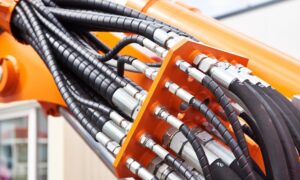
Hydraulic hose failure is a common and costly problem. That’s why maximizing the lifespan of your hydraulic hoses is crucial for saving money, preventing accidents, and keeping your equipment running smoothly. Today, we’ll offer some practical tips to help you get the most out of your hydraulic hoses.
For high-quality industrial hoses designed to meet the demands of your specific application, contact J.W. Roberts. We offer a wide selection of hoses suitable for various industries and operating conditions, ensuring you get the right hose for the job.
Factors Affecting Hydraulic Hose Lifespan
When it comes to wear and tear of hydraulic hoses, problems can originate from both outside and inside the hose.
External threats include physical damage. Abrasion from rubbing against other surfaces, impacts from debris, and rough handling can all damage the protective outer cover and internal reinforcement layers.
Environmental conditions also play a big role. Extreme heat or cold, sunlight (UV radiation), ozone, chemicals, and moisture can all degrade the hose material, making it brittle or causing it to crack.
Incorrect installation is surprisingly one of the main causes of hydraulic hose damage. Twisting, kinking, bending the hose beyond its recommended radius, or failing to properly support it puts excessive stress on the hose and can lead to premature failure.
Internal factors are equally important. The hydraulic fluid itself can cause problems if it’s not compatible with the hose material.
High pressure and extreme temperatures, especially exceeding the hose’s rated limits, weaken the hose over time. Plus, hoses can experience pressure surges, also known as impulse. These are sudden spikes in pressure that can act like mini-hammers inside the hose, gradually weakening it.
Tips for Preventing Early Industrial Hose Failure
Maximizing hydraulic hose lifespan comes down to smart choices and consistent care. Don’t just buy any industrial hose; match it to the specific application. Consider the pressure, temperature, the type of hydraulic fluid, and the surrounding environment. Choosing the right size and type of hose is equally important. An undersized hose will struggle under pressure, while the wrong type might not be compatible with the fluid.
Careful installation and routing are crucial. Always follow the manufacturer’s guidelines – they know their hoses best. Avoid twisting, kinking, or bending the hose beyond its minimum bend radius. Use clamps and supports to secure the hose and prevent it from moving around, which can cause rubbing and wear. Minimize stress on the hose by using flexible hose assemblies in areas with movement.
Make it a habit to visually inspect hoses for cuts, abrasions, cracks, leaks, or bulges. Check connections for leaks regularly. Periodically pressure test the hoses to identify weaknesses before they lead to catastrophic failures.
Additional preventive measures can significantly extend hose life as well. Protective sleeving can shield the hose from abrasion and harsh environments. Strain relief devices at connections prevent stress on the hose where it’s most vulnerable.
Expert Advice and Supply for Industrial Hose
Extend the life of your hydraulic systems with high-quality hoses from J.W. Roberts. Our wide selection and expert advice ensure you get the perfect hose for your application. Contact us today for reliable hoses and supporting products.
